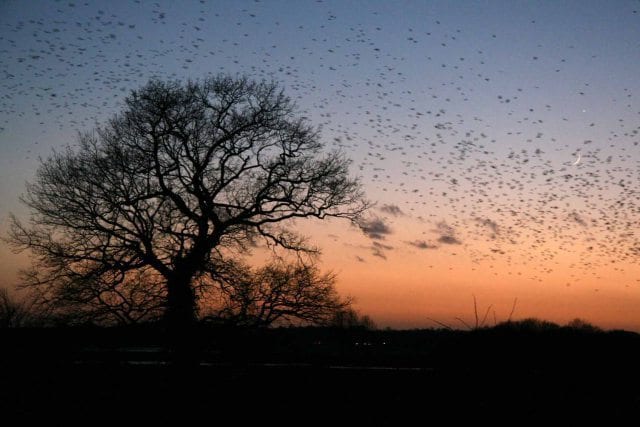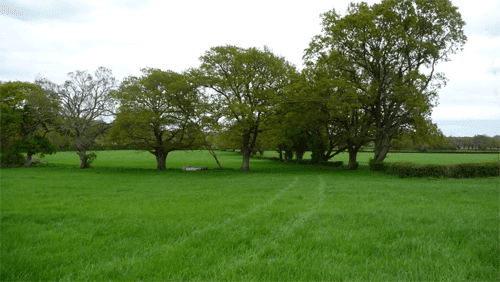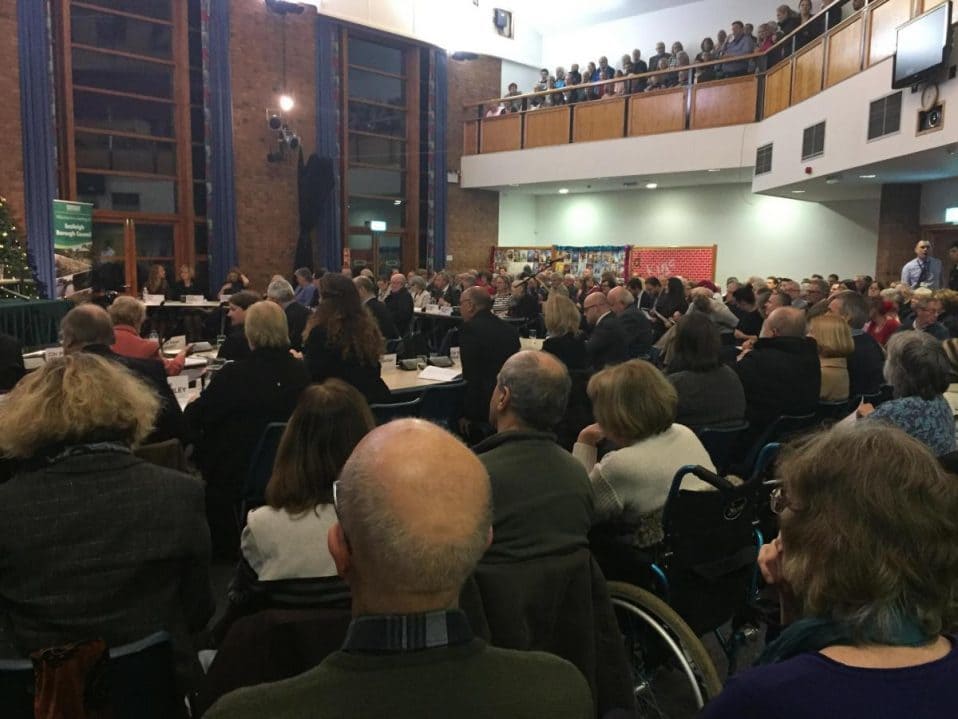Remarkable rook displays threatened by EBC’s Local Plan
Jennifer Gosling, 8 February 2017: Recently posted on Facebook, this short video by local resident Jennifer Gosling gives a glimpse of the wonderful sight and sound of the thousands of rooks that congregate daily during winter months each year in the fields and woods of Bishopstoke. At dusk, they normally display and then fly to roost in Upper Barn Copse. If Eastleigh Borough Council chooses options B and C of its emerging Local Plan, these fields – which are not only the rooks’ meeting ground but also a valuable corridor for an enormous variety of other wildlife – will be lost forever. Join our campaign against options B and C now! We must do all we can to ensure future generations can also enjoy these truly magnificent aerial displays.
Lobby dismay at 250 homes plan for Fair Oak
Hampshire Chronicle, 4 February 2017: A CAMPAIGN group has hit out at plans to build more than 200 homes in Eastleigh in advance of a Local Plan for the area, which lies close to Winchester City Council district. An application to build 250 homes in Fair Oak was approved at the local area committee meeting in Bishopstoke. Prior to the meeting, Action against Destructive Development Eastleigh (ADD) outlined their opposition to developer Drew Smith’s application to build on Mortimers Lane. In an open letter, the group stated the application at Pembers Farm undermined Eastleigh Borough Council’s consultation process on its new Local Plan, which determines future development in the borough. A draft Local Plan is due to be published later this year.
Pembers Hill Farm planning approval: did Eastleigh councillors do Fair Oak justice?
ADD UPDATE, 31 January 2017: On Wednesday 25 January 2017, upwards of 100 people watched Eastleigh Borough Council (EBC)’s Local Area Committee for Bishopstoke, Fair Oak and Horton Heath approve an outline application for “up to 250 dwellings” at Pembers Hill Farm in Fair Oak. After some well-argued speeches from objectors, local residents were shocked by the way in which what will probably be one of the most significant planning applications in Fair Oak/Bishopstoke this year was decided in about 15 minutes with no discussion at all of the issues. Given that EBC’s stated remit of Local Area Committees is “to discuss major planning applications and to review progress on important projects”, and that “members of the public are invited to attend these meetings and to listen to the debate”, it seems regrettable that all of the discussion that mattered had clearly taken place before the meeting.
In their brief speeches, several of the councillors expressed regret that they had to approve the application, as to do otherwise would have meant “the council losing at appeal”. As Councillor Des Scott put it: “We are handcuffed by the NPPF [the National Planning Policy Framework, which sets out the government’s planning policies for England].” Several experts, including the independent planning consultant West Waddy, dispute this analysis. Given that the application, whether the council liked it to or not, linked the development to the much larger plan to develop 6,000+ new houses north of Fair Oak and Bishopstoke – the so-called options B and C of the council’s Local Plan – West Waddy argues the opposite, namely that the application ran counter to the government’s planning policy advice in the NPPF. As West Waddy wrote in a paper prepared ahead of the meeting: “To accord any weight to the strategic option of locating development on the option B and C land would fundamentally conflict with the government’s planning policy advice in the NPPF.”
Separately, others question the councillors’ judgement on grounds of failing to represent people’s views by approving an application on assumption of passage on appeal.
Even if the councillors’ reasoning was sound, there are big question marks over whether they should have approved the application on the basis of the facts presented to them. Drew Smith, the developer, submitted the application in 2015, so councillors had no shortage of time to iron out any problems, but it appears they didn’t do so. Indeed, to outside observers, it seems they knowingly decided to overlook key problems.
There are three particular issues where the application appears to fall short:
Firstly, the design statement for the application states that the density will be 30 dwellings per hectare, which is a typical medium density. On 7 April 2016 Dawn Errington, the council’s planning officer, wrote to the developer suggesting that as it was agreed that only 6.4 hectares or less were developable (versus the original 12.4 hectares), the application title should be amended to “up to 190 dwellings”. The applicant came back a few days later (in response to landscape and other concerns) with a revised plan showing only 119 buildings on the site. Some of these are clearly ‘semis’ but as the application is for ‘housing’ it would be impossible to see how there could be more than 160 houses on the revised plan (itself a generous estimate). As this drawing was the one shown to the meeting to support the application for “up to 250 dwellings” (which would be around 40 dwellings per hectare), how could approval be granted? If that wasn’t bad enough, neither Dawn Errington nor any councillor made any reference to this anomaly, despite the fact it was pointed out both before and during the meeting. To make matters even worse, the ‘up to’ was hardly ever mentioned either.
If the developer has any idea how to deliver 250 houses, it hasn’t shared this with the people of Fair Oak. Why, therefore, wasn’t the number on the application reduced before the decision taken?
Secondly, there was no mention in the planner’s presentation of the concerns expressed by the borough’s own landscape officer, Louise O’Driscoll, who had originally described the scheme as “poorly screened” and “obtrusive”. Indeed, she said that the amount of green space in the revised scheme was still “completely inadequate” and raised concerns about how Gore Copse and the floodwater attenuation ponds (which cannot be used as green space) will be maintained. “There should be a reduction on our usual density requirement to allow for belts of screen planting around the margins of the site and for the large SUDS [sustainable urban drainage systems] areas, which aren’t required in existing urban contexts,” she wrote on 14 April 2016.
Thirdly, and most crucially for the councillors, is the correspondence to them from Dr David Sear, a professor in river processes at Southampton University, who – using strongly worded language – has condemned the methodology of the applicant’s flood risk engineers. In an email to councillors on 22 January 2017, he wrote: “I was horrified to see that not only had they used an outdated and unsuitable hydrological model to design their proposal, they had also failed to include standard uplifts for rainfall which in light of recent UK floods was increased to 40% in the future, and 10% to account for urban creep (the building of drives and conservatories post development).”
Dr Sear’s opinion matters: as well as being a local resident well aware of the risk to Fair Oak’s centre from the stream arising on Pembers Hill Farm, he sits on the National Flood and Erosion Risk Management technical advisory group, where he provides input into the development of policy and strategy for the Department for Environment, Food and Rural Affairs and the Environment Agency. He has over 27 years’ experience of working on flooding, flows, sediment transport and ecosystem impacts of a range of land use and channel management, during which time he has worked on river management issues across the UK and overseas, most recently dealing with recent flooding in Cumbria.
The clear suggestion from his letter is that more space needs to be given over to attenuation. On a matter as critical as flood risk, the councillors are being very ‘brave’ to leave this to be determined by a planning condition. As Louise O’Driscoll, the borough’s landscape officer, wrote on 14 April 2016: “It is now established in case law that projects must be defined in sufficient detail, even at outline stage, to allow its effects on the environment to be identified and assessed.”
Why have councillors not insisted on this?
In summary, councillors have approved an application for 250 dwellings, supported by a drawing for at best 160 dwellings on which its own landscape officer wants more open space (i.e., fewer dwellings) and one of the country’s foremost experts says that, for the risks to Fair Oak to be mitigated, more attenuation is required (which also means fewer dwellings). Given all this, perhaps half the number of dwellings approved can actually be built on the site at the density the landscape officer wants and with adequate flood protection.
Last week’s approval was therefore based not only on a very misleading presentation but also on one that had received no scrutiny at all. Why does this matter? Surely all this will be dealt with at the detailed approval stage?
It matters because councillors passed an unachievable target number of dwellings. Executives at Drew Smith would be only human if they set their designers the task of getting as close to that figure as they can, with a resulting very high density (highly visually intrusive) on what there is left to build on.
It also matters because of the effect that halving the number of dwellings would have on what the application has promised the community. For example:
- The 88 promised affordable dwellings would be halved, if not rendered completely ‘non-viable’, by the cost of providing enough flood attenuation by ponds on a sloping site;
- The highways improvements promised would be reduced; and
- The funds available for improvements to Gore Copse as a local amenity, and commuted sums for its maintenance, would also be threatened.
At a time when the council’s bargaining power with developers is at its strongest, it should have tied down the details of the application far more closely. Now the councillors – together with Fair Oak parish council and all of us who live locally (whether in Fair Oak or not) – face an uphill struggle trying to ensure we get a scheme at the low density the landscape officer says is required and at the quality the site deserves.
Eastleigh councillors ignore locals and vote for Pembers development
PEMBERS HILL FARM DECISION, 26 January 2017: It was very nearly a full house at Stoke Park Junior school yesterday evening, with around 100 people looking to see whether Eastleigh councillors from the Bishopstoke, Fair Oak and Horton Heath Local Area Committee would stand up for their communities.
Chairman Trevor Mignot started the evening by telling everyone that the decision on Drew Smith’s application for 250 houses at Pembers Hill Farm was not about options B and C (of Eastleigh’s Local Plan) and the application had to be seen as a standalone decision. He warned speakers from the public (all of eight whom were against the application) to avoid raising the merits of B and C.
Planning Officer Dawn Errington opened the item with a long explanation as to why the scheme had to be approved as it complied with the National Planning Policy Framework (NPPF).
The eight passionate and well-argued speeches from the floor drew loud applause and cheering from the audience.
After the planning agent’s predictable speech, Councillor Des Scott started his speech by saying “this application is premature” (to huge applause from the audience).
He then went on to explain why he had to support ‘approval’ as “we are handcuffed by the NPPF” and “if we don’t grant this it will go to appeal. We have got to defend applications we know we can win. We can’t win this one.”
This set the tone (had they been agreeing this at the pre-meeting?). One by one councillors expressed regret but said they would vote in support.
Councillor Anne Winstanley was more unapologetic and said “we need to get back to building houses so I will be voting for the application.”
Councillor Rob Rushton said: “I understand the need for housing and we need to go by planning law. We would lose this on appeal. I’m reluctant but I will be voting in favour.”
He then proposed the motion, which was seconded by Anne Winstanley and carried unanimously.
The lack of recognition by the councillors and planning officer of the area’s traffic problem was, amongst other things, extremely noticeable – an omission that will infuriate all those already caught in the area’s traffic chaos. More houses will, of course, only make the problem worse but perhaps the councillors and planners feel they have no responsibility for it?
What’s clear is that Eastleigh councillors are not listening to their electorate or, if they are, they are choosing to ignore us. In a democracy, this only ends one way! We may have lost last night’s vote, but we fight on – more determined that ever before.
ADD speaks with Radio Solent about Pembers Hill Farm development
ADD UPDATE, 25 January 2017: Gin Tidridge, Independent Parish Councillor for Bishopstoke and an ADD spokesperson, today spoke with Julian Clegg on Radio Solent’s breakfast show about local residents’ objections to the hostile planning application for 250 houses at Pembers Hill Farm on Mortimers Lane in Fair Oak. As ADD supporters know, Eastleigh councillors from Bishopstoke, Fair Oak and Horton Heath will TONIGHT make a decision on this application. We encourage anyone who objects to this proposal – which signals the start of option C in Eastleigh Borough Council (EBC)’s emerging Local Plan – to attend this meeting to support friends and neighbours who will be urging councillors to reject the plan.
THE MEETING WILL BE HELD AT 7PM TONIGHT (25 JANUARY 2017) IN MAIN HALL, STOKE PARK JUNIOR SCHOOL, UNDERWOOD ROAD, BISHOPSTOKE SO50 6GR.
Click here for a longer version of Gin’s interview, which starts with a reminder of local residents’ opinions at EBC’s full council meeting on 15 December. Gin’s interview itself is half way through.
Crucial meeting on Pembers Hill Farm application tonight: see you there!
MEETING NOTICE: 7PM TONIGHT (25 JANUARY 2017), MAIN HALL, STOKE PARK JUNIOR SCHOOL, UNDERWOOD ROAD, BISHOPSTOKE SO50 6GR. Eastleigh councillors from Bishopstoke, Fair Oak and Horton Heath will TONIGHT decide upon the hostile planning application from developer Drew Smith for 250 houses at Pembers Hill Farm on Mortimers Lane in Fair Oak. We encourage all of you to attend this meeting to support friends and neighbours who will urging councillors to reject this application. Councillors have received many letters and documents detailing powerful arguments why this application should be rejected, including from their own officers! A strong turnout tonight will leave them in no doubt about local residents’ disgust towards this calculating, irresponsible and unsustainable proposal. We look forward to seeing you there.
Upham Parish Council strongly objects to Pembers Hill Farm application
Upham Parish Council, 24 January 2017: In a strongly worded letter to Eastleigh borough councillors, David Ashe, chairman of Upham Parish Council, has today set out powerful arguments why they should reject Drew Smith’s hostile application for 250 houses at Pembers Hill Farm on Mortimers Lane in Fair Oak. A Local Area Committee comprising of councillors from Bishopstoke, Fair Oak and Horton Heath will decide on the application at a meeting tomorrow evening.
Mr Ashe writes: “The arguments put forward for approval of this very opportunistic application, by both the applicant and your own officers’ report, rely heavily on the suggestion that a decision has already been taken to progress with B and C as the preferred option [of the council’s emerging Local Plan, namely for 6,000+ houses and a major new road north of Allbrook, Bishopstoke and Fair Oak].”
He continues: “You are being asked to approve a scheme for 250 houses for which your landscape officers recommend rejection on grounds of over dense development and visual impact. One of the country’s foremost experts on hydrology has condemned it, as it relies on obsolete methodology to justify the amount of attenuation proposed. Professor Sear’s clear concerns can only be met by more land being given over to attenuation, whilst the landscape officers call for more public open space. Something has to give, and it is the number of dwellings being applied for. An application for 250 houses on this site is therefore clearly unsustainable and threatens severe flooding to the centre of Fair Oak.
“The applicant suggests that to approve this application will be ‘held to the council’s credit’ by the inspector. What will really be ‘held to the council’s credit’ will be a sound local plan development process, one that establishes a clear evidence base before taking any decision on B and C.
“You have previously taken the very sensible view that this application should be deferred pending a decision on the Local Plan. Why should you change that opinion?”
To view Mr Ashe’s letter, click here.
To read planning consultant West Waddy’s supporting documentation, referred to in Mr Ashe’s letter, click here. (Please note this version corrects several typos in the original one sent to councillors.) As you will see, West Waddy’s opinion is that approving this application in the light of both the applicant’s and council officers’ concerns, would fly in the face of guidance in the National Planning Policy Framework.
Thought your countryside was safe?
Forum, January 2017: As a planning battle in the Hampshire borough of Eastleigh
rages, Mark Baylis looks at the challenges facing Eastleigh borough councillors, the two key options they are deliberating, the environment in which they are making decisions, and their motivation for choosing one option over another, despite evidence to the contrary. The lesson for rural communities everywhere, Mark suggests, is to remain vigilant and take nothing for granted.
CPRE warns EBC against approving hostile Pembers Hill Farm development
CPRE Hampshire, 20 January 2017: In a letter to Eastleigh Borough Council (EBC), the Campaign to Protect Rural England (CPRE) today warns councillors against approving the hostile application for 250 houses at Pembers Hill Farm at a key meeting this Wednesday.
CPRE writes that a decision on this site “is premature and would prejudice any objective assessment of the strategic options that are being considered as part of the Local Plan process,” giving tacit approval for options B and C, and therefore pre-empting “any possibility for interested parties to comment and challenge these options through the examination in public.”
CPRE also notes that EBC has not updated its housing needs to take account of the newest official projections, and is not therefore in accordance with current government guidance.










